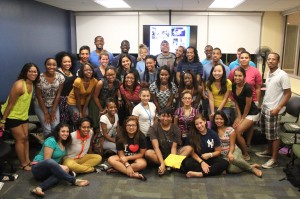Engagement has always been my goal. Since high school, I always tried to get people involved in all the organizations that I was a part of because I loved them so much. I was passionate, full of life, excitement, and in high hopes of doing good. The nonsensical, overly involved, high school student form then is still very much alive today, but with different goals. My mission? Social change. My support system? The LEAD Office and the George Mason University Community. My (sort to speak) weapons? Students.
Engaging students in different initiatives is very important to the work that I do in LEAD, and in the world that I am a part of. Education, not just formal education, helps enlighten people and gets them thinking about what they can do in our society to help make a positive change. While working at the LEAD Office this year, I learned a lot of valuable lessons of what engagement can mean.
- Engagement can be reaching out to as many people as possible, but it shouldn’t always be about the numbers.
- Engagement provides opportunities for students to open up to new experiences and knowledge that they may not always have been exposed to.
- Engagement can make a huge different in someone’s life and in the world around them.
Though having as many people attend an event can show quantitative elements of engagement, which is important as well, I have come to realize that impact is just as important. An event filled with hundreds of people can sometimes only have a real impact on about 10. Yet a smaller event of 30 people can yield a positive impact on all 30 students, allowing them to come back and be committed to a cause. For me, it’s important to be able to engage as many students as possible, but also be conscious of the impact I hope to make. Some ways I’ve been able to do that this year have included the Leadership Mason Conference. Though not all of the hundreds of students that were present attended the seminar I co-facilitated, I could feel the impact I left on the students by the dialogue that ensued after the presentation.
One thing that I’ve seen engagement work in positive ways is by allowing students to be opened up to new experiences here at Mason. I’ve been lucky enough to lead facilitations on Queer People of Color for the LGBTQ* community through Pride Alliance, which has allowed students, of all races and heritages, to understand what is means like to be at the intersection of two marginalized identities as well as practicing intersectional social activism.
Engagement also allows leaders to impact someone’s life. Last year, I was able to talk to an incoming freshman about my experiences here at Mason. She was unsure of where she wanted to go, so I joined her for lunch and opened up about my Mason experience. I was able to share with her my love for The Office of Diversity, Inclusion, and Multicultural Education (ODIME) and what it meant to have gone through the Student Transition Empowerment Program (STEP). In between plates of burritos and dessert, I was able to illustrate the beauty of my Mason experience. A few months later, I found that the student had decided not only to come to Mason, but to apply and participate in the STEP program, just as I had the summer before my freshman year. When we caught up, she shared with me that I was the reason she chose to come to Mason and it was through my involvement and stories of my passions here on campus that she decided to make Mason her home.
To me, that is engagement. Even if I wasn’t able to speak in front of the whole school and share my story, being able to make a difference in one person’s life can be just as rewarding.

